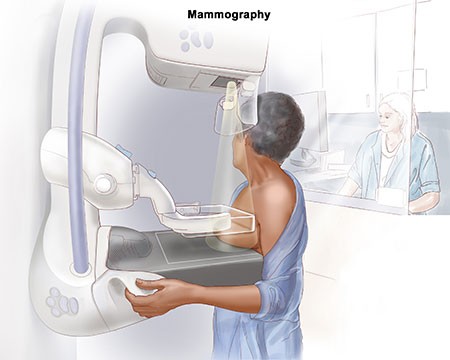What is a mammography?
Mammography is a specific type of imaging that uses a dedicated x-ray system for the examination of breasts. A mammography exam, called a mammogram, is used as a screening tool to detect early breast cancer in women experiencing no symptoms and to detect and diagnose breast disease in women experiencing symptoms such as a lump, pain or nipple discharge.
Why is mammography important?
Mammography plays a central part in early detection of breast cancer because it can show changes in the breast up to two years before a patient or doctor can feel them. Breast cancer is the second most common cancer in the world and, by far, the most frequent cancer among women. Screening mammography is recommended by the American Cancer Society for women aged 40 and above. Research has shown that annual mammograms lead to early detection of breast cancers, when they are mostly curable and breast conservation therapies are available.
While mammography is the best screening tool for breast cancer available today, mammograms do not detect all breast cancers.
How often should I have a screening mammogram?
The professional societies American Cancer Society (ACS) and U.S. Preventive Services Task Force (USPSTF) recommend that women aged 40-49 years have regular mammograms every year, and women above 50 years of age, every two years.
Women who are at a higher risk of developing breast cancer should see a doctor for advice. You may need to go for screening earlier and more frequently.
What are the benefits and risks?
BENEFITS
Imaging of the breast improves the detection of small tumours. When cancers are small, there are more treatment options and a cure is more likely.
RISKS
The radiation dose received by the patient during a mammogram is about the same as the average person receives from background radiation in three months.

Women should always inform their doctor or the diagnostic radiographer if there is any possibility that they are pregnant.
False positive mammograms: five percent to fifteen percent of screening mammograms require more testing such as additional mammograms or ultrasound. Most of these tests turn out to be normal.
What is the mammography technique used at FV Hospital?
Digital images are obtained using a Computed Radiography (CR) mammography system. It involves small radiation exposure. A skilled diagnostic radiographer positions and compresses the breast between two plates. Then highly specialized x-ray equipment takes two pictures of each breast from two directions. Mildly uncomfortable for most women, mammography can be painful for some. But compression of the breast is necessary to flatten and reduce the thickness of the breast. The x-ray beam should penetrate as few layers of overlapping tissues as possible.
Computerized mammography images can then be enlarged or highlighted. If there is a suspicious area, doctors can use the computer to take a closer look.
How should I prepare for a mammogram?
Do not schedule your mammogram the week before your period, if your breasts are usually tender during this time. The best time for a mammogram is from the last day of your period to 2 weeks after the first day of your last period.
Always inform your doctor or the diagnostic radiographer if there is any possibility that you may be pregnant.
The day of your exam, wear a comfortable two-piece outfit and do not use deodorant, perfume, powder or ointment at armpits or breasts.
Please bring along all your previous mammogram films so that they can be compared with the current one.
You will be asked to fill in a questionnaire before the start of your mammogram examination. Please ask the diagnostic radiographer if you are unsure of how to answer any of the questions.
How is a mammogram performed?
The mammogram is performed by a specially trained diagnostic radiographer who usually is a female radiographer.
In the procedure room, you will be asked to change into a gown and to stand at the x-ray machine.
The diagnostic radiographer will position your breast in the mammography unit. Your breast will be placed on a special platform and compressed with a paddle (often made of clear Plexiglas or other plastic). You will feel pressure on the breast as it is squeezed by the compressor. Some women with sensitive breasts may experience discomfort. If this is the case, schedule the procedure when your breasts are least tender.
Breast compression is necessary in order to:
- Even out the breast thickness so that all of the tissue can be visualized,
- Spread out the tissue so that small abnormalities won’t be obscured by overlying breast tissue,
- Allow the use of a lower x-ray dose since a thinner amount of breast tissue is being imaged,
- Hold the breast still in order to eliminate blurring of the image caused by motion.
- Reduce x-ray scatter to increase sharpness of picture.
The diagnostic radiographer will stand behind a glass shield during the x-ray exposure. You will be asked to slightly change positions between images. The routine views are top-to-bottom view and oblique side view. The same procedure will be repeated for the other breast.
How long does a mammography exam take?
The examination process should take about half an hour. When the mammography is completed you will be asked to wait until the radiologist examines the images to determine if additional images are needed.
Breast implants
Women with breast implants should also follow the same guidelines for checking their breast like those without implants.
The differences in imaging breast with and without implants are as follows:
- Examination of augmented breasts (breasts with implants) may last longer as more views may be required,
- Breast implants can also impede accurate mammogram readings because both silicone and saline implants are not transparent for x-rays and can block a clear view of the tissues underneath them, especially if the implant has been placed in front of, rather than beneath, the chest muscles. It is estimated that about 25% of breast tissue will not be seen on the mammogram as it will be covered by the implant. The diagnostic radiographer will use special techniques to get clearer x-rays of your breasts. You might find this uncomfortable.
- As with the usual mammogram, compression is an important aspect of mammography examination. Diagnostic radiographers take special care to use minimal compression on the breast implant during the breast x-ray procedure. It is highly unlikely, but possible, that this compression could cause or worsen leaking of silicone or change the shape or texture of the breast.
When can I expect results?
Your examination will be reviewed by a radiologist. Your referring doctor will be informed immediately of any suspicious findings. You will receive a formal written report either the same day or within two (2) days depending on your clinical and diagnostic requirements.
How do I schedule the ultrasound exam?
For further information and appointments, kindly contact our Imaging Department at FV Hospital: (08) 54 11 34 00

 Vi
Vi 












